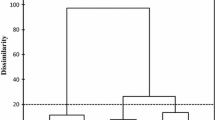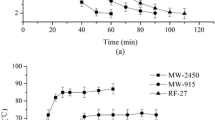Abstract
Rapeseeds were adjusted to moisture contents of 9, 11, 13, and 15 % and treated with microwaves under 800 W for 0, 1, 2, 3, 4, 5, 6, and 7 min at a frequency of 2,450 MHz and oil was extracted with a press to investigate possibility of enhancing oil extraction yield by press, minor component content, and oxidative stability of the pressed oil. The results indicated that microwave pretreatment of rapeseed could increase the oil extraction yield, and both microwave time and initial moisture content of rapeseed had significant effects on the oil extraction yield (p < 0.001). Total tocopherol content in the oil extracted by press first increased and then decreased depending on the period of microwave radiation (p < 0.001), and the initial moisture content had no significant effect on the tocopherol content (p > 0.05). Phytosterol and polyphenol contents increased with increasing microwave time and with decreasing initial moisture content of rapeseeds (p < 0.001). An F test revealed there were significant interactions between the effects of microwave time and initial moisture content on both polyphenol content and oil extraction yield. The oxidative stability of oil were improved with increasing microwave time and decreasing initial moisture content (p < 0.001), and there were significant positive correlations with total polyphenol and phytosterol contents. Therefore, it is advisable to treat rapeseeds with low initial moisture content by microwaves prior to oil extraction by press because it results in a relatively good oil extraction yield by cold press, with a high amount of phenolic, tocopherol, and phytosterol. Microwave pretreatment had a positive effect on oxidative oil stability in comparison to the untreated oil.




Similar content being viewed by others
References
Aguilera, J. M., & Stanley, D. W. (1999). Microstructural principles of food processing and engineering (2nd edition). New York: Aspen.
Anderson, D. (1996). A primer on oils processing technology. In Y. H. Hui (Ed.), Bailey's industrial oil and fat products. Wiley, Hoboken, Vol 4 (pp. 1–60). USA: New York.
Anjum, F., Anwar, F., Jamil, A., & Iqbal, M. (2006). Microwave roasting effects on the physico-chemical composition and oxidative stability of sunflower seed oil. Journal of the American Oil Chemists' Society., 83(9), 777–784.
Ayappa, K., Davis, H., Davis, E., & Gordon, J. (1991). Analysis of microwave heating of materials with temperature–dependent properties. AIChE Journal, 37(3), 313–322.
Azadmard-Damirchi, S., Habibi-Nodeh, F., Hesari, J., Nemati, M., & Achachlouei, B. F. (2010). Effect of pretreatment with microwaves on oxidative stability and nutraceuticals content of oil from rapeseed. Food Chemistry, 121(4), 1211–1215.
Baldioli, M., Servili, M., Perretti, G., & Montedoro, G. (1996). Antioxidant activity of tocopherols and phenolic compounds of virgin olive oil. Journal of the American Oil Chemists' Society, 73(11), 1589–1593.
Bao, Z., Xu, R., & Zhang, S. (2002). Determination of phytosterol and cholesterol in oil by capillary gas chromatography. Chinese Journal of Analytical Chemistry, 30(12), 1490–1493.
Beveridge, T. H. J., Li, T. S. C., & Drover, J. C. G. (2002). Phytosterol content in American ginseng seed oil. Journal of Agricultural and Food Chemistry, 50(4), 744–750.
Decareau, R. V., & Mudgett, R. E. (1985). Microwaves in the food processing industry (pp. 28–32). London: Academic.
Dolde, D., Vlahakis, C., & Hazebroek, J. (1999). Tocopherols in breeding lines and effects of planting location, fatty acid composition, and temperature during development. Journal of the American Oil Chemists' Society, 76(3), 349–355.
Galano, A., Francisco-Marquez, M., & Alvarez-Idaboy, J. R. (2011). Canolol: a promising chemical agent against oxidative stress. The Journal of Physical Chemistry B, 115(26), 8590–8596.
Hamama, A. A., Bhardwaj, H. L., & Starner, D. E. (2003). Genotype and growing location effects on phytosterols in canola oil. Journal of the American Oil Chemists' Society, 80(11), 1121–1126.
Holser, R. (2003). Properties of refined milkweed press oil. Industrial Crops and Products, 18(2), 133–138.
Koski, A., Pekkarinen, S., Hopia, A., Wähälä, K., & Heinonen, M. (2003). Processing of rapeseed oil: effects on sinapic acid derivative content and oxidative stability. European Food Research and Technology, 217(2), 110–114.
Koski, A., Psomiadou, E., Tsimidou, M., Hopia, A., Kefalas, P., Wähälä, K., et al. (2002). Oxidative stability and minor constituents of virgin olive oil and cold-pressed rapeseed oil. European Food Research and Technology, 214(4), 294–298.
Leonelli, C., & Mason, T. J. (2010). Microwave and ultrasonic processing: now a realistic option for industry. Chemical Engineering and Processing: process Intensification, 49(9), 885–900.
Maheshwari, P., Stanley, D., Van De Voort, F., & Gray, J. (1981). Effect of microwave treatment on the microstructure of dehulled rapeseed. Cereal Chemistry, 58(5), 381–384.
Matthäus, B., Brühl, L., & Amoneit, F. (2008). The DGF rapeseed oil award—A tool to improve the quality of virgin edible rapeseed oil. Lipid Technology, 20(2), 31–34.
Ponne, C. T., Möller, A. C., Tijskens, L. M. M., Bartels, P. V., & Meijer, M. M. T. (1996). Influence of microwave and steam heating on lipase activity and microstructure of rapeseed (Brassica napus). Journal of Agricultural and Food Chemistry, 44(9), 2818–2824.
Przybylski, R., & Eskin, N. A. M. (2006). Minor components and the stability of vegetable oils—Roman Przybylski and NA Michael Eskin share why the stability of oil cannot be predicted based solely on fatty acid composition and how the. Inform-International News on Fats Oils and Related Materials, 17(3), 186–189.
Ramesh, M., Rao, P. H., & Ramadoss, C. S. (1995). Microwave treatment of groundnut (Arachis hypogaea): Extractability and quality of oil and its relation to lipase and lipoxygenase activity. LWT-Food Science and Technology, 28(1), 96–99.
Ratnayake, W., & Daun, J. (2004). Chemical composition of canola and rapeseed oils. In F. D. Gunstone (Ed.), Rapeseed and Canola Oil (pp. 37–73). Oxford: Blackwell.
Salazar-González, C., San Martín-González, M. F., López-Malo, A., & Sosa-Morales, M. E. (2011). Recent studies related to microwave processing of fluid foods. Food and Bioprocess Technology, 5(1), 31–46.
Salvador, M., Aranda, F., & Fregapane, G. (1999). Contribution of chemical components of Cornicabra virgin olive oils to oxidative stability. A study of three successive crop seasons. Journal of the American Oil Chemists' Society, 76(4), 427–432.
Schwartz, H., Ollilainen, V., Piironen, V., & Lampi, A. M. (2008). Tocopherol, tocotrienol and plant sterol contents of vegetable oils and industrial fats. Journal of Food Composition and Analysis, 21(2), 152–161.
Shahidi, F., & Naczk, M. (1992). An overview of the phenolics of canola and rapeseed: chemical, sensory and nutritional significance. Journal of the American Oil Chemists' Society, 69(9), 917–924.
Spielmeyer, A., Wagner, A., & Jahreis, G. (2009). Influence of thermal treatment of rapeseed on the canolol content. Food Chemistry, 112(4), 944–948.
Starmans, D. A. J., & Nijhuis, H. H. (1996). Extraction of secondary metabolites from plant material: a review. Trends in Food Science & Technology, 7(6), 191–197.
Tan, C., Che Man, Y., Jinap, S., & Yusoff, M. S. A. (2001). Effects of microwave heating on changes in chemical and thermal properties of vegetable oils. Journal of the American Oil Chemists' Society, 78(12), 1227–1232.
Thostenson, E., & Chou, T. W. (1999). Microwave processing: fundamentals and applications. Composites Part A: applied Science and Manufacturing, 30(9), 1055–1071.
Uquiche, E., Jeréz, M., & Ortíz, J. (2008). Effect of pretreatment with microwaves on mechanical extraction yield and quality of vegetable oil from Chilean hazelnuts (Gevuina avellana Mol). Innovative Food Science & Emerging Technologies, 9(4), 495–500.
Veldsink, J. W., Muuse, B. G., Meijer, M. M. T., Cuperus, F. P., van de Sande, R. L. K. M., & van Putte, K. P. A. M. (1999). Heat pretreatment of oilseeds: effect on oil quality. Lipid/Fett, 101(7), 244–248.
Venkatesh, M., & Raghavan, G. (2004). An overview of microwave processing and dielectric properties of agri-food materials. Biosystems Engineering, 88(1), 1–18.
Vetrimani, R., Jyothirmayi, N., Haridas Rao, P., & Ramadoss, C. (1992). Inactivation of lipase and lipoxygenase in cereal bran, germ and soybean by microwave treatment. Lebensmittel-Wissenschaft+ Technologie, 25(6), 532–535.
Vlahakis, C., & Hazebroek, J. (2000). Phytosterol accumulation in canola, sunflower, and soybean oils: effects of genetics, planting location, and temperature. Journal of the American Oil Chemists' Society, 77(1), 49–53.
Wang, H. (2010). Review and future development of rapeseed industry in China. Chinese Journal of Oil Crop Sciences, 32(2), 300–302.
Wijesundera, C., Ceccato, C., Fagan, P., & Shen, Z. (2008). Seed roasting improves the oxidative stability of canola (B. napus) and mustard (B. juncea) seed oils. European Journal of Lipid Science and Technology, 110(4), 360–367.
Zacchi, P., & Eggers, R. (2008). High–temperature pre–conditioning of rapeseed: a polyphenol–enriched oil and the effect of refining. European Journal of Lipid Science and Technology, 110(2), 111–119.
Acknowledgments
We are grateful to the Industry Technology System of Rapeseed (ITSR) and the Twelfth Five-Year Science and Technology Supporting Plan of China for financial support.
Author information
Authors and Affiliations
Corresponding author
Rights and permissions
About this article
Cite this article
Yang, M., Huang, F., Liu, C. et al. Influence of Microwave Treatment of Rapeseed on Minor Components Content and Oxidative Stability of Oil. Food Bioprocess Technol 6, 3206–3216 (2013). https://doi.org/10.1007/s11947-012-0987-2
Received:
Accepted:
Published:
Issue Date:
DOI: https://doi.org/10.1007/s11947-012-0987-2




